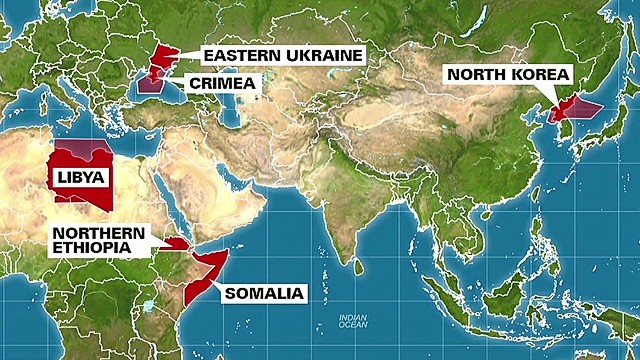Story highlights
- Planes also fly over Iraq, Afghanistan and other countries where bullets fly
- The FAA does tell U.S. carriers not to travel over some areas, issues warnings for others
- CNN aviation analyst says airlines can go above and beyond government regulations
- Commercial pilot says captains work with dispatchers, can request adjusted route
When passengers boarded Malaysia Airlines Flight 17 last week, they couldn't have known they were about to fly over a battlefield.
But hours later, at 33,000 feet above eastern Ukraine, a missile ended the lives of 298 innocent civilians.
That flight wasn't the only one in the corridor that day nor was it the lone one to fly above a conflict area.
After MH17 was shot down the Federal Aviation Administration told U.S. airlines they could no longer fly in that region.
And after a rocket launched from Gaza landed within a mile of Ben Gurion airport in Tel Aviv, the agency banned flights from the United States to Israel for 24 hours.
In other areas, including ones where there is violence on the ground, the FAA restricts what U.S. planes can do.
Over Iraq, U.S.-based airlines can fly as long as their planes are above 20,000 feet. That is out of range of most -- but as MH17 proved, not all -- missiles. There are warnings in effect for eight other areas, including Syria and Afghanistan. The threats include missiles and small arms fire, but airlines can fly there if they want.
The decision for the airlines comes down to this: Do they just adhere to government regulations, which in effect establish minimum requirements, or do they use more caution?
"Government regulations are a floor. The government says, 'You can't be in the business unless you do this,'" CNN aviation analyst and former inspector general for the U.S. Department of Transportation Mary Schiavo said on "Erin Burnett OutFront." "You can go above it. Your airline can be safer, you can be more secure."
On the ground in Iraq, the well-funded terrorist group ISIS is fighting government troops, while above there is a busy highway in the sky with hundreds of flights.
Every day Delta Flight 7 travels from Dubai to Atlanta and soars over Iraq.
There are other flights with U.S. ties that travel over fighting.
United Flight 82 each day goes over Afghanistan as it travels from Newark, New Jersey, to Delhi, India.
It would be difficult to reroute these flights without increasing the time in the air by hours.
"Airlines have always had to make decisions about whether particular cities are safe to operate to," said Tony Tyler, the chief executive officer of the International Air Transport Association.
MH17's route from Amsterdam in the Netherlands to Kuala Lumpur, Malaysia, would have been more than 6,000 miles. There were more than 800 flights that flew that corridor in the week before the shoot down.
"We followed that flight path accordingly," said Hugh Dunlavey, commercial director for Malaysia Airlines said. "And it was accepted by the European air traffic control. And like many other airlines that had been flying that route for many, many weeks and with hundreds of airlines passing that route every day, we believed it was safe to do so."
After MH17 was shot down in eastern Ukraine, that region joined Crimea, north Korea, northern Ethiopia, Libya and Somalia as off limits to U.S. aircraft.
Pilots have some input into the route.
"We have a collaborative decision process with the dispatcher," said 777 pilot Les Abend, a CNN aviation analyst. "Myself as the pilot in command as captain of the plane and the dispatcher (who plans the flight). The dispatcher has a lot of the information; I can't get all of it. We get it in a NOTAM -- Notice to Airman (from the FAA). So this information, whether it be intelligence information about air space, information about weather, it's all part of that process. If there's something that we see that says, 'Hey, I don't like this,' we make a phone call. Most of the time we get this electronically."
In the case of MH17, the minimum altitude requirement (set by Ukrainian authorities) was 32,000 feet. It was supposed to be safe.
"Threat information is only as good as the intelligence supplied by air traffic control and its cooperating governments," Abend says in an editorial on why Malaysia Airlines is not at fault for flying where Flight 17 was traveling.









